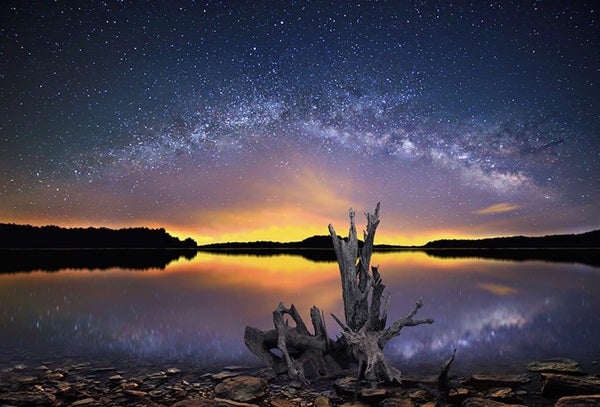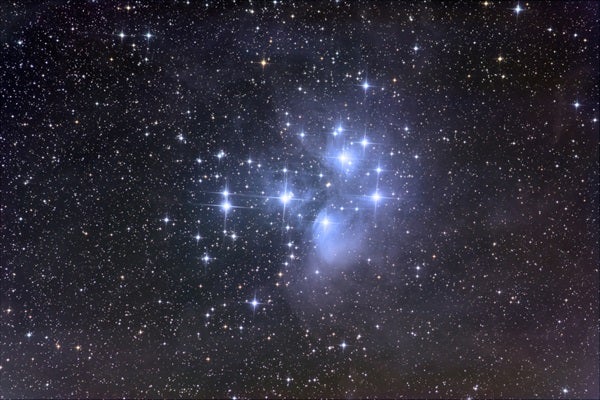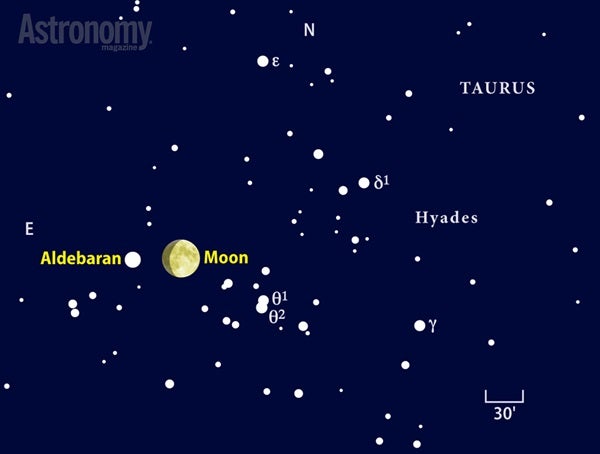Uranus reached opposition and peak visibility four months ago, but it remains a tempting target. The outer planet appears nearly halfway to the zenith in the west-southwest soon after darkness falls. The magnitude 5.9 world lies in southeastern Pisces, 2.8° west of the 4th-magnitude star Omicron (ο) Piscium. Although Uranus shines brightly enough to glimpse with the naked eye under a dark sky, binoculars make the task much easier. A telescope reveals the planet’s blue-green disk, which spans 3.5″.
Saturday, February 17
Although the Moon reached its New phase just two days ago, its rapid orbital motion carries it into view after the Sun goes down this evening. Look low in the west-southwest about an hour after sunset and you’ll see its 4-percent-lit crescent hanging in the twilight like the smile of the Cheshire Cat.
Mercury reaches superior conjunction at 7 a.m. EST. This means the innermost planet lies on the opposite side of the Sun from Earth and remains hidden in our star’s glare. It will return to view in the evening sky at the end of February.
Sunday, February 18
Two of the finest deep-sky objects shine prominently on February evenings. The Pleiades and Hyades star clusters appear highest in the south as darkness falls but remain conspicuous until well past midnight. The Pleiades, also known at the Seven Sisters and M45, looks like a small dipper to the naked eye. The larger Hyades forms the V-shaped head of Taurus the Bull. Although both look nice without optical aid, binoculars show them best.
Head outside before dawn and you can’t miss Jupiter. The giant planet rises before 12:30 a.m. local time and climbs 30° high in the south by the time twilight commences. Jupiter shines at magnitude –2.1, which makes it the brightest point of light in the night sky, and resides among the much dimmer stars of the constellation Libra. A telescope reveals the planet’s 38″-diameter disk.
Tuesday, February 20
One of the sky’s largest asterisms — a recognizable pattern of stars separate from a constellation’s form — occupies center stage on February evenings. To trace the so-called Winter Hexagon, start with southern Orion’s luminary, Rigel. From there, the hexagon makes a clockwise loop. The second stop is brilliant Sirius in Canis Major. Next, pick up Procyon in the faint constellation Canis Minor, then the twins Castor and Pollux in Gemini, followed by Capella in Auriga, Aldebaran in Taurus, and finally back to Rigel.
Wednesday, February 21
The dwarf planet Ceres reached opposition and peak visibility in late January, and it remains a fine sight this month. It currently shines at magnitude 7.2 and is an easy object to spot through binoculars. The largest member of the asteroid belt resides in the northern part of the constellation Cancer the Crab, which appears in the east once darkness falls and climbs highest in the south around 11 p.m. local time. This evening, Ceres lies 0.6° due south of the magnitude 5.7 star Sigma1 (σ1) Cancri.
Thursday, February 22
The half-lit Moon rides high in the south just after sunset and then sinks slowly toward the western horizon throughout the rest of the evening. Our satellite officially reaches its First Quarter phase at 3:09 a.m. EST tomorrow morning. The Moon spends the evening hours in western Taurus, not far from the Pleiades and Hyades star clusters.
The waxing gibbous Moon lies just east of the 1st-magnitude star Aldebaran this evening. Depending on where in North America you live, the gap appears to be 4° or 5° in early evening and grows about 0.5° every hour thereafter. Aldebaran represents the eye of Taurus the Bull and appears to mark one tip of the V-shaped Hyades star cluster. In reality, Aldebaran lies only about half as far from Earth as the cluster does.
Saturday, February 24
Mars follows about two hours behind Jupiter these winter mornings. The magnitude 0.9 Red Planet rises shortly after 2 a.m. local time and appears 25° high as twilight starts to paint the sky. It lies against the backdrop of southern Ophiuchus, and this morning has a close encounter with the 9th-magnitude globular star cluster NGC 6287. Astroimagers will want to capture the planet as it passes just 15′ north of the cluster. Unfortunately, the view of Mars through a telescope proves disappointing — its disk spans only 6″ and shows no detail.
Sunday, February 25
Although Saturn passed on the opposite side of the Sun from Earth only two months ago, it already appears conspicuous in the southeastern sky before dawn. From mid-northern latitudes, the ringed planet lies 15° above the horizon as twilight begins. Saturn shines at magnitude 0.6 and appears significantly brighter than any of the background stars in its host constellation, Sagittarius the Archer.












